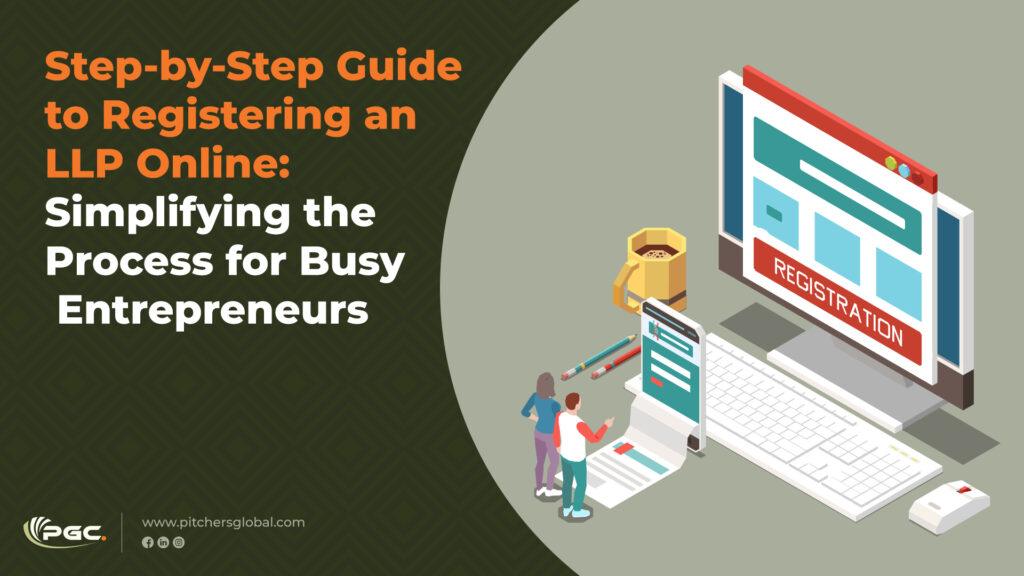Starting a tech startup is an exciting journey, but the complexities of setting up your business structure and register an LLP Online can feel overwhelming. For entrepreneurs like Rahul Verma, the founder of a technology startup in Bengaluru, the goal is to focus on growth and innovation, not paperwork.
Opting for a Limited Liability Partnership (LLP) combines the benefits of a partnership with the advantage of limited liability. However, navigating through LLP registration can be time-consuming and confusing.
This guide breaks down the process into easy steps, helping busy entrepreneurs register an LLP online without the hassle.
Why Choose an LLP?

Before diving into the registration process, it’s important to understand why LLP might be the right choice for your business:
- Limited Liability: Protects your personal assets from business liabilities.
- Flexibility: Offers the operational flexibility of a partnership with less stringent compliance compared to a private limited company.
- Tax Benefits: LLPs are taxed at a lower rate than companies, making it a cost-effective structure for startups.
Now, let’s explore how to simplify the LLP registration process.
How to Register an LLP Online?
Step 1: Choose the Right Service Platform

Rahul, like many busy entrepreneurs, prefers to register his LLP online to save time and effort. When looking for the right registration service, focus on:
- Online platforms that offer streamlined, user-friendly experiences.
- Transparent cost structures with no hidden fees.
- Comprehensive support for documentation and compliance.
Once you’ve identified a trustworthy service, you’re ready to begin.
Step 2: Obtain a Digital Signature Certificate (DSC)

The first step in any online LLP registration process is to secure a Digital Signature Certificate (DSC) for all designated partners. The DSC is crucial for digitally signing forms and documents during registration.
- How to get it: Several Certifying Authorities issue DSCs online. Choose a reliable provider, fill out the necessary forms, and submit required documents like identity proof and address proof.
- Processing time: Typically takes 1-2 days.
Step 3: Apply for Director Identification Number (DIN)

The next step is to apply for a Director Identification Number (DIN) for all the partners. DIN is a unique identification number required by the designated partners of the LLP.
- How to apply: File Form DIR-3 on the Ministry of Corporate Affairs (MCA) portal, which includes basic details of the designated partners along with proof of identity and residence.
- Processing time: Usually processed within 1 day.
Step 4: Name Reservation for Your LLP
Choosing a name for your LLP is an important task. You need to ensure that the chosen name isn’t already in use and complies with LLP Naming Guidelines.
- How to reserve a name: Use the RUN-LLP form available on the MCA portal to check the availability of your desired LLP name. You can propose two names, and the Registrar will approve one based on availability and compliance.
- Processing time: Typically takes 2-5 days.
Step 5: File the Incorporation Form (FiLLiP)

Once the name is approved, the FiLLiP (Form for Incorporation of Limited Liability Partnership) needs to be filed. This form consolidates the details of your LLP, such as the partners’ information, the business location, and the contribution of each partner.
- Document requirements: PAN card, address proof, and photos of the partners, as well as the office address proof (rental agreement or ownership documents).
- Submission: After filling out the form, upload it along with the DSC on the MCA portal.
Step 6: Draft and File the LLP Agreement

The LLP Agreement outlines the rights, duties, and responsibilities of the partners. It is one of the most critical documents in the registration process and must be filed within 30 days of incorporation.
- Key aspects of the LLP Agreement:
- Profit-sharing ratios.
- Roles and responsibilities of each partner.
- Rules for decision-making and dispute resolution.
After drafting, file the LLP Agreement using Form 3 on the MCA portal.
Step 7: Certificate of Incorporation

Once all documents are approved, the Registrar will issue a Certificate of Incorporation. Congratulations! Your LLP is officially registered.
- What next: With the Certificate of Incorporation, apply for a Permanent Account Number (PAN) and Tax Deduction and Collection Account Number (TAN) for your LLP. These are essential for opening a business bank account and complying with tax regulations.
Key Tips for Busy Entrepreneurs

- Seek Professional Help: If you’re tight on time, consider hiring an expert or a service platform that handles everything—from name reservation to document submission.
- Cost Transparency: Always check for hidden fees before finalizing any service platform. Make sure you get detailed cost breakdowns upfront.
- Stay Organized: Ensure that you have all required documents ready. This minimizes delays and speeds up the registration process.
Conclusion – Register an LLP Online
LLP registration doesn’t have to be a time-consuming or stressful task. By following these steps and using a reliable online platform, entrepreneurs like Rahul Verma can register their LLP quickly and focus on growing their business.
With expert guidance and streamlined services from Pitchers Global, you can get your LLP up and running in no time—leaving you free to concentrate on what really matters: building your startup!
